SAR Image Registration Based on SAR-SIFT and Template Matching
Abstract
1. Introduction
- In the pre-registration stage, for downsampled images, the SAR-SIFT algorithm is combined with iterative optimization to obtain pre-registered images. This approach reduces computational costs while maintaining high registration accuracy and avoiding large errors.
- In the template matching method of the fine registration stage, a new similarity measure method is proposed by combining the phase congruency of the frequency domain and the gradient of the spatial domain.
- In the fine registration stage, the images obtained through the template matching method are further subjected to adaptive local stretching transformations to achieve registration in terrain-undulated regions.
2. Materials and Methods
2.1. Pre-Registration
2.2. Fine Registration
2.2.1. Feature Point Extraction
2.2.2. Similarity Measure Method Combining Phase Congruency and Gradient
2.2.3. Local Correction for Terrain-Undulated Areas
- Determination of rectangular bounding boxes for candidate terrain-undulated regions: For the candidate terrain-undulated regions obtained through DBSCAN clustering, feature points are resampled, and template matching is re-performed to obtain new matching pairs. Based on the distribution characteristics of these matching pairs, the transformation ranges in the x and y directions are calculated, and rectangular bounding boxes are constructed for each candidate region. If the newly obtained matching pairs satisfy the final transformation matrix, it indicates that the candidate region is not a terrain-undulated region and will be excluded from subsequent correction processes.
- Sampling and detection of terrain-undulated region boundaries: In both the x and y directions, dense sampling is performed starting from the center point of the rectangular bounding box, extending outward on both sides to detect the boundary positions of the terrain-undulated regions. For each sampling point, if it is located in a flat region, sampling proceeds toward the undulating region and vice versa. By analyzing the spatial distribution characteristics of the sampling points, the boundary regions of topographic relief are preliminarily identified, leading to a more precise boundary of the undulating area.
- Refined division of terrain-undulated regions: Based on the distance between boundary sampling points, a threshold is employed to determine whether adjacent sampling points belong to the same terrain-undulated region. If the distance exceeds the preset threshold, they are classified into independent regions; otherwise, they are regarded as part of the same continuous region. Through this procedure, the candidate terrain-undulated regions are further subdivided into multiple specific sub-regions.
- Calculation of local stretching transformation ratios: For each subdivided terrain-undulated region, the local stretching transformation ratio is calculated based on the local transformation characteristics of matching pairs. Since most terrain-undulated regions are situated in mountainous areas with no distinct features, mismatches are prone to occur. In this step, uniform sampling is used to obtain matching pairs, and an affine transformation model is employed to preliminarily eliminate mismatches. The stretching transformation ratio is determined by the correct matching pair with the maximum transformation distance within the region, ensuring that the stretching transformation fully adapts to the local variation characteristics of the terrain-undulated region, thereby improving correction accuracy. As shown in Figure 4, a simplified top view of local transformation induced by topographic relief is shown, where points a1 and b1, a as well as points a5 and b5, denote the corresponding boundary regions, while a2, a3, a4 correspond to b2, b3, b4 as correct matching pairs. In this case, the transformation distances for these three correct matching pairs are 1.5, 3, and 2, respectively. The stretching transformation ratio is determined by matching pairs a3 and b3 with the largest transformation distances.
- Application of adaptive local stretching transformation: Based on the calculated stretching transformation ratios, an adaptive local stretching transformation is applied to each terrain-undulated region. Taking the transformation in the x-direction as an example, the transformation formulas are given as follows:where and represent the left and right boundaries of the terrain-undulated region in the x-direction, respectively; and denote the x coordinates of the transformation pairs determined in step (4) for the pre-registered image and the reference image, respectively; and represent the stretching transformation ratios for the x direction. denotes the transformed coordinate at position x. The transformation in the y-direction follows the same principle as in the x-direction.
3. Results
3.1. Parameter Settings
3.2. Evaluation Criteria
3.3. Effectiveness of Iterative Matching in Pre-Registration Stage
3.4. Effectiveness of the Proposed Similarity Measure Method
3.5. Effectiveness of Adaptive Local Stretching Transformation
3.6. The Registration Performance of the Proposed Method
4. Discussion
5. Conclusions
Author Contributions
Funding
Institutional Review Board Statement
Informed Consent Statement
Data Availability Statement
Conflicts of Interest
References
- Li, Z.; Jia, Z.; Yang, J.; Kasabov, N. A method to improve the accuracy of SAR image change detection by using an image enhancement method. ISPRS J. Photogramm. Remote Sens. 2020, 163, 137–151. [Google Scholar] [CrossRef]
- Jiang, W.; Sun, Y.; Lei, L.; Kuang, G.; Ji, K. Change detection of multisource remote sensing images: A review. Int. J. Digit. Earth 2024, 17, 2398051. [Google Scholar] [CrossRef]
- Quan, Y.; Tong, Y.; Feng, W.; Dauphin, G.; Huang, W.; Xing, M. A novel image fusion method of multi-spectral and sar images for land cover classification. Remote Sens. 2020, 12, 3801. [Google Scholar] [CrossRef]
- Ye, Y.; Zhang, J.; Zhou, L.; Li, J.; Ren, X.; Fan, J. Optical and SAR image fusion based on complementary feature decomposition and visual saliency features. IEEE Trans. Geosci. Remote Sens. 2024, 62, 1–15. [Google Scholar] [CrossRef]
- Scaioni, M.; Marsella, M.; Crosetto, M.; Tornatore, V.; Wang, J. Geodetic and remote-sensing sensors for dam deformation monitoring. Sensors 2018, 18, 3682. [Google Scholar] [CrossRef]
- Guo, S.; Zuo, X.; Wu, W.; Yang, X.; Zhang, J.; Li, Y.; Huang, C.; Bu, J.; Zhu, S. Mitigation of tropospheric delay induced errors in TS-InSAR ground deformation monitoring. Int. J. Digit. Earth 2024, 17, 2316107. [Google Scholar] [CrossRef]
- Zitova, B.; Flusser, J. Image registration methods: A survey. Image Vis. Comput. 2003, 21, 977–1000. [Google Scholar] [CrossRef]
- Lin, Y.; Gao, Y.; Wang, Y. An improved sum of squared difference algorithm for automated distance measurement. Front. Phys. 2021, 9, 737336. [Google Scholar] [CrossRef]
- Mahmood, A.; Khan, S. Correlation-coefficient-based fast template matching through partial elimination. IEEE Trans. Image Process. 2011, 21, 2099–2108. [Google Scholar] [CrossRef]
- Viola, P.; Wells, W.M., III. Alignment by maximization of mutual information. Int. J. Comput. Vis. 1997, 24, 137–154. [Google Scholar] [CrossRef]
- Kovesi, P. Image features from phase congruency. Videre J. Comput. Vis. Res. 1999, 1, 1–26. [Google Scholar]
- Bunting, P.; Labrosse, F.; Lucas, R. A multi-resolution area-based technique for automatic multi-modal image registration. Image Vis. Comput. 2010, 28, 1203–1219. [Google Scholar] [CrossRef]
- Lowe, D.G. Distinctive image features from scale-invariant keypoints. Int. J. Comput. Vis. 2004, 60, 91–110. [Google Scholar] [CrossRef]
- Schwind, P.; Suri, S.; Reinartz, P.; Siebert, A. Applicability of the SIFT operator to geometric SAR image registration. Int. J. Remote Sens. 2010, 31, 1959–1980. [Google Scholar] [CrossRef]
- Wang, S.; You, H.; Fu, K. BFSIFT: A novel method to find feature matches for SAR image registration. IEEE Geosci. Remote Sens. Lett. 2011, 9, 649–653. [Google Scholar] [CrossRef]
- Wang, F.; You, H.; Fu, X. Adapted anisotropic Gaussian SIFT matching strategy for SAR registration. IEEE Geosci. Remote Sens. Lett. 2014, 12, 160–164. [Google Scholar] [CrossRef]
- Fan, J.; Wu, Y.; Wang, F.; Zhang, Q.; Liao, G.; Li, M. SAR image registration using phase congruency and nonlinear diffusion-based SIFT. IEEE Geosci. Remote Sens. Lett. 2014, 12, 562–566. [Google Scholar]
- Dellinger, F.; Delon, J.; Gousseau, Y.; Michel, J.; Tupin, F. SAR-SIFT: A SIFT-like algorithm for SAR images. IEEE Trans. Geosci. Remote Sens. 2014, 53, 453–466. [Google Scholar] [CrossRef]
- Wang, B.; Zhang, J.; Lu, L.; Huang, G.; Zhao, Z. A uniform SIFT-like algorithm for SAR image registration. IEEE Geosci. Remote Sens. Lett. 2015, 12, 1426–1430. [Google Scholar] [CrossRef]
- Liu, F.; Bi, F.; Chen, L.; Shi, H.; Liu, W. Feature-area optimization: A novel SAR image registration method. IEEE Geosci. Remote Sens. Lett. 2016, 13, 242–246. [Google Scholar] [CrossRef]
- Li, Y.; Stevenson, R. Incorporating global information in feature-based multimodal image registration. J. Electron. Imaging 2014, 23, 023013. [Google Scholar] [CrossRef]
- Gong, M.; Zhao, S.; Jiao, L.; Tian, D.; Wang, S. A novel coarse-to-fine scheme for automatic image registration based on SIFT and mutual information. IEEE Trans. Geosci. Remote Sens. 2013, 52, 4328–4338. [Google Scholar] [CrossRef]
- Ye, Y.; Shan, J. A local descriptor based registration method for multispectral remote sensing images with non-linear intensity differences. ISPRS J. Photogramm. Remote Sens. 2014, 90, 83–95. [Google Scholar] [CrossRef]
- Xiang, Y.; Wang, F.; You, H. An automatic and novel SAR image registration algorithm: A case study of the Chinese GF-3 satellite. Sensors 2018, 18, 672. [Google Scholar] [CrossRef]
- Paul, S.; Pati, U.C. SAR image registration using an improved SAR-SIFT algorithm and Delaunay-triangulation-based local matching. IEEE J. Sel. Top. Appl. Earth Obs. Remote Sens. 2019, 12, 2958–2966. [Google Scholar] [CrossRef]
- Wang, M.; Zhang, J.; Deng, K.; Hua, F. Combining optimized SAR-SIFT features and RD model for multisource SAR image registration. IEEE Trans. Geosci. Remote Sens. 2021, 60, 1–16. [Google Scholar] [CrossRef]
- Chen, S.; Zhong, S.; Xue, B.; Li, X.; Zhao, L.; Chang, C.I. Iterative scale-invariant feature transform for remote sensing image registration. IEEE Trans. Geosci. Remote Sens. 2020, 59, 3244–3265. [Google Scholar] [CrossRef]
- Venkatesh, S.; Owens, R. An Energy Feature Detection Scheme. IEEE Trans. Pattern Anal. Mach. Intell. 1989, 11, 358–367. [Google Scholar]

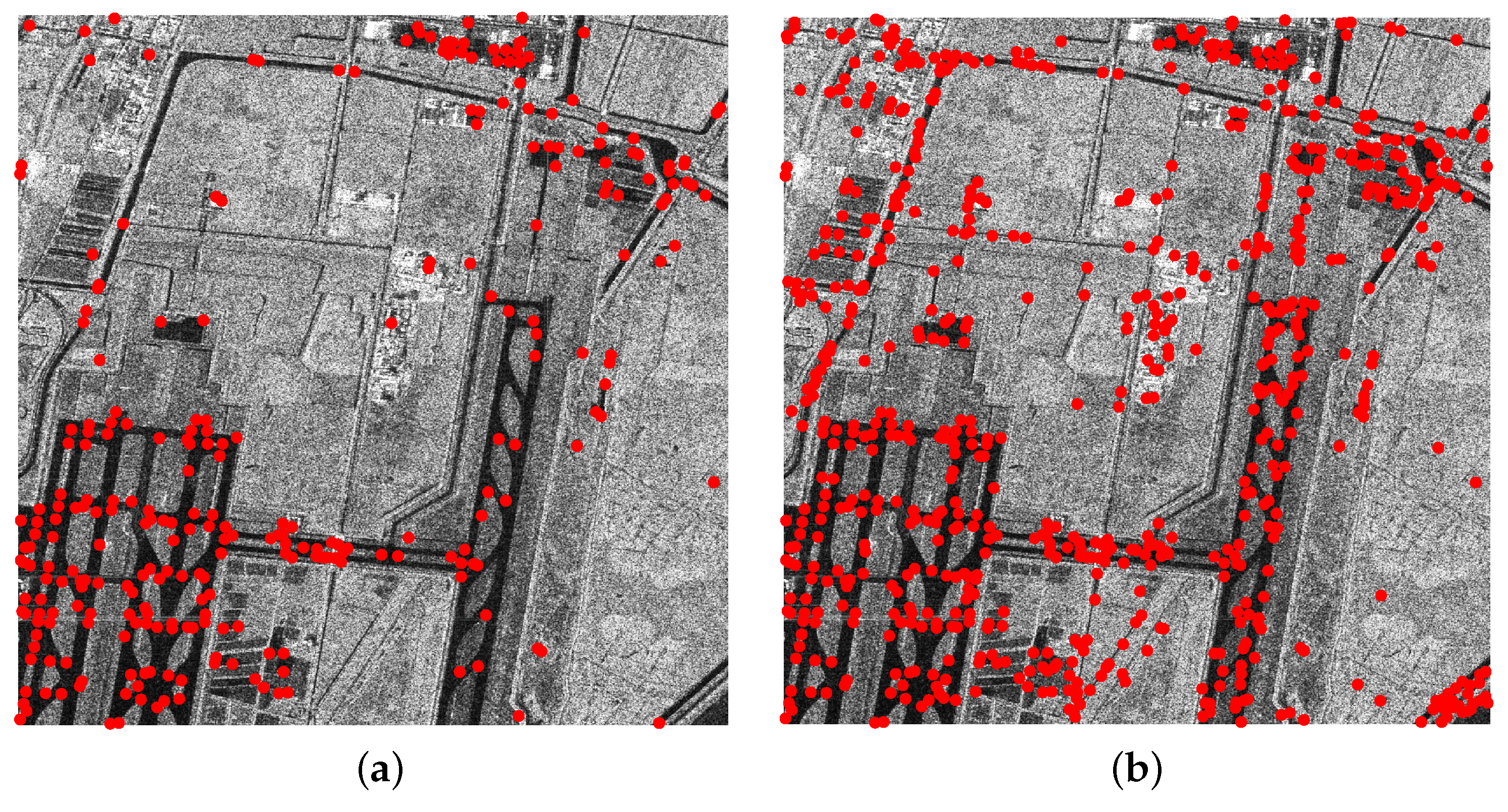
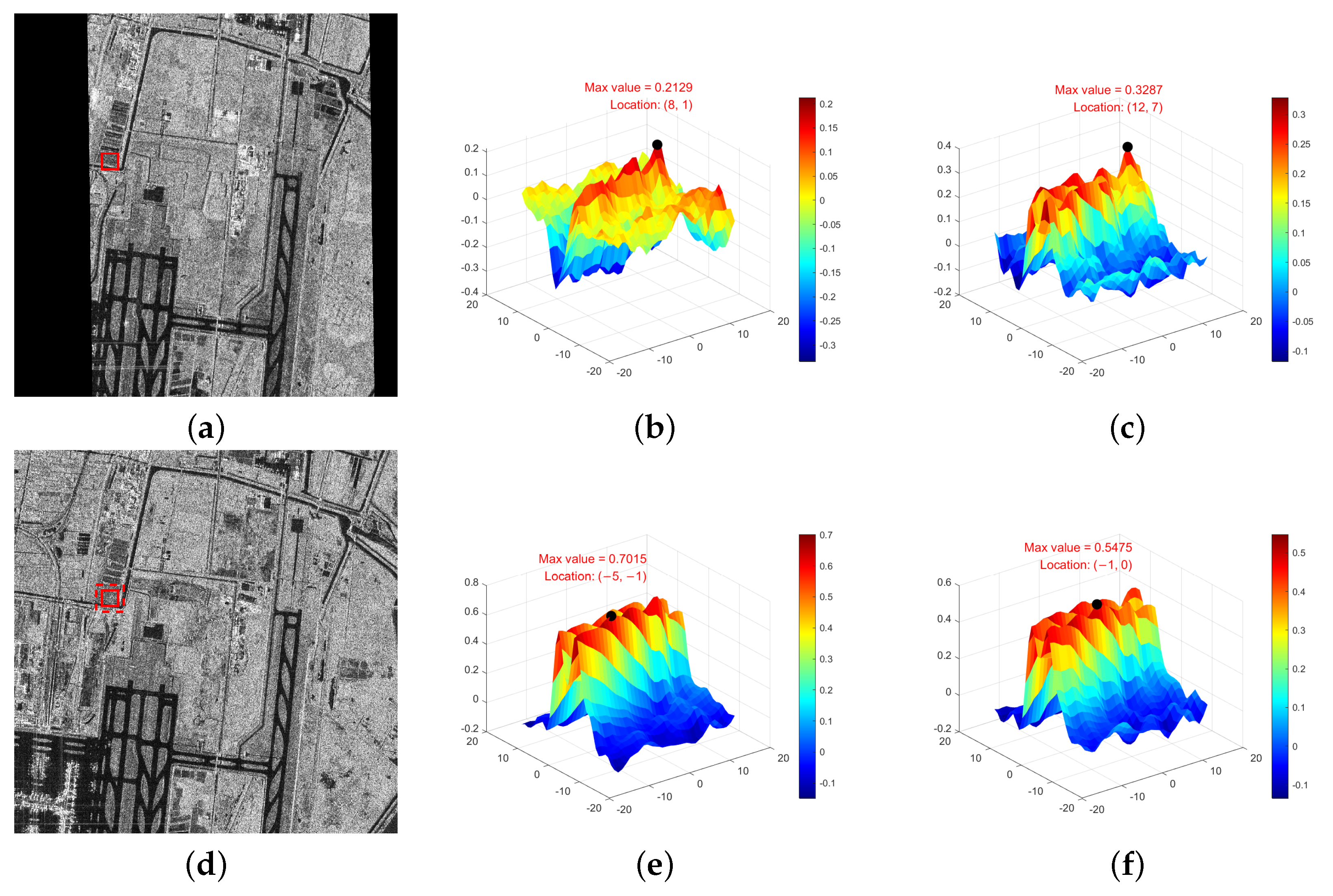
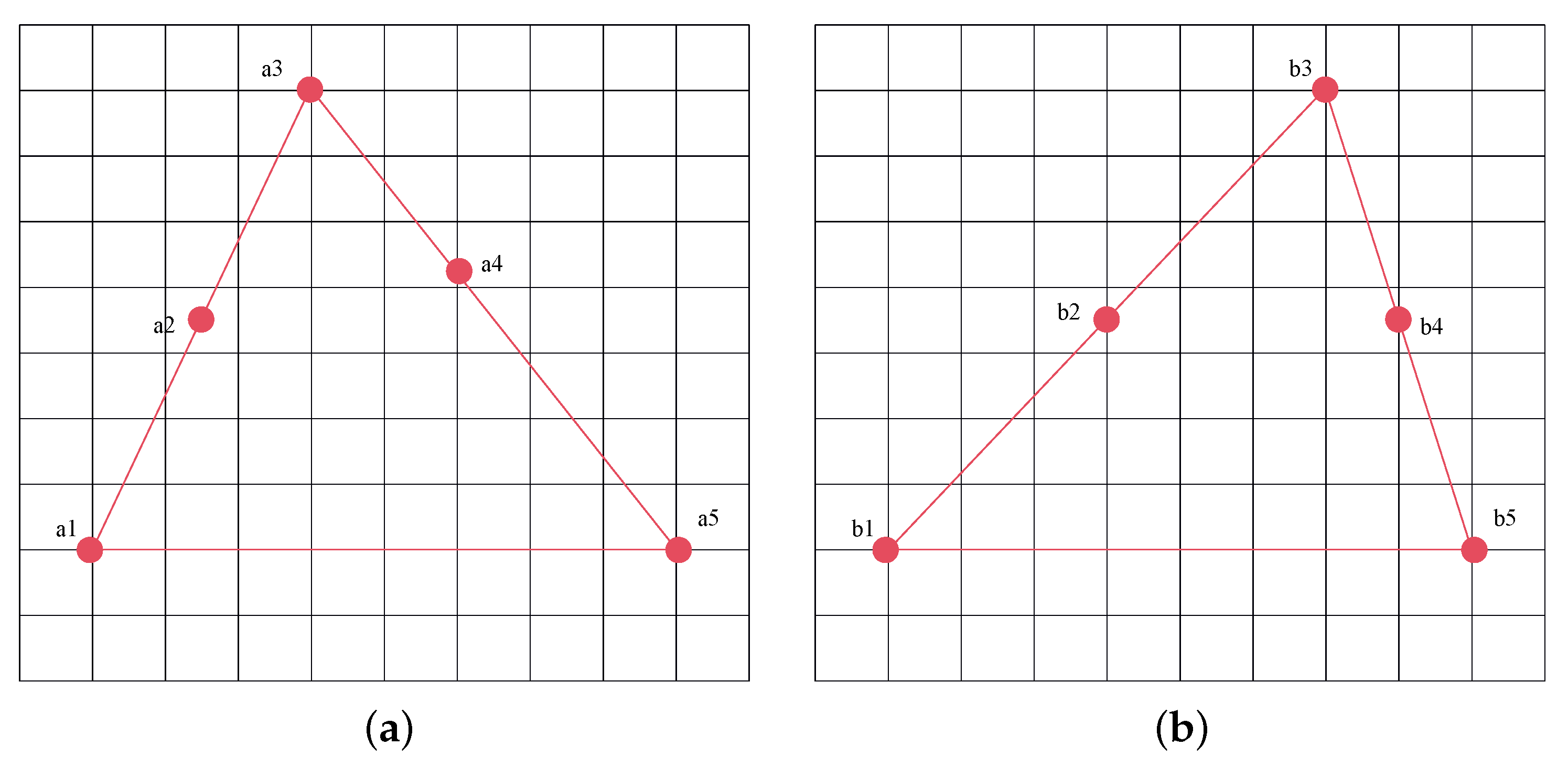
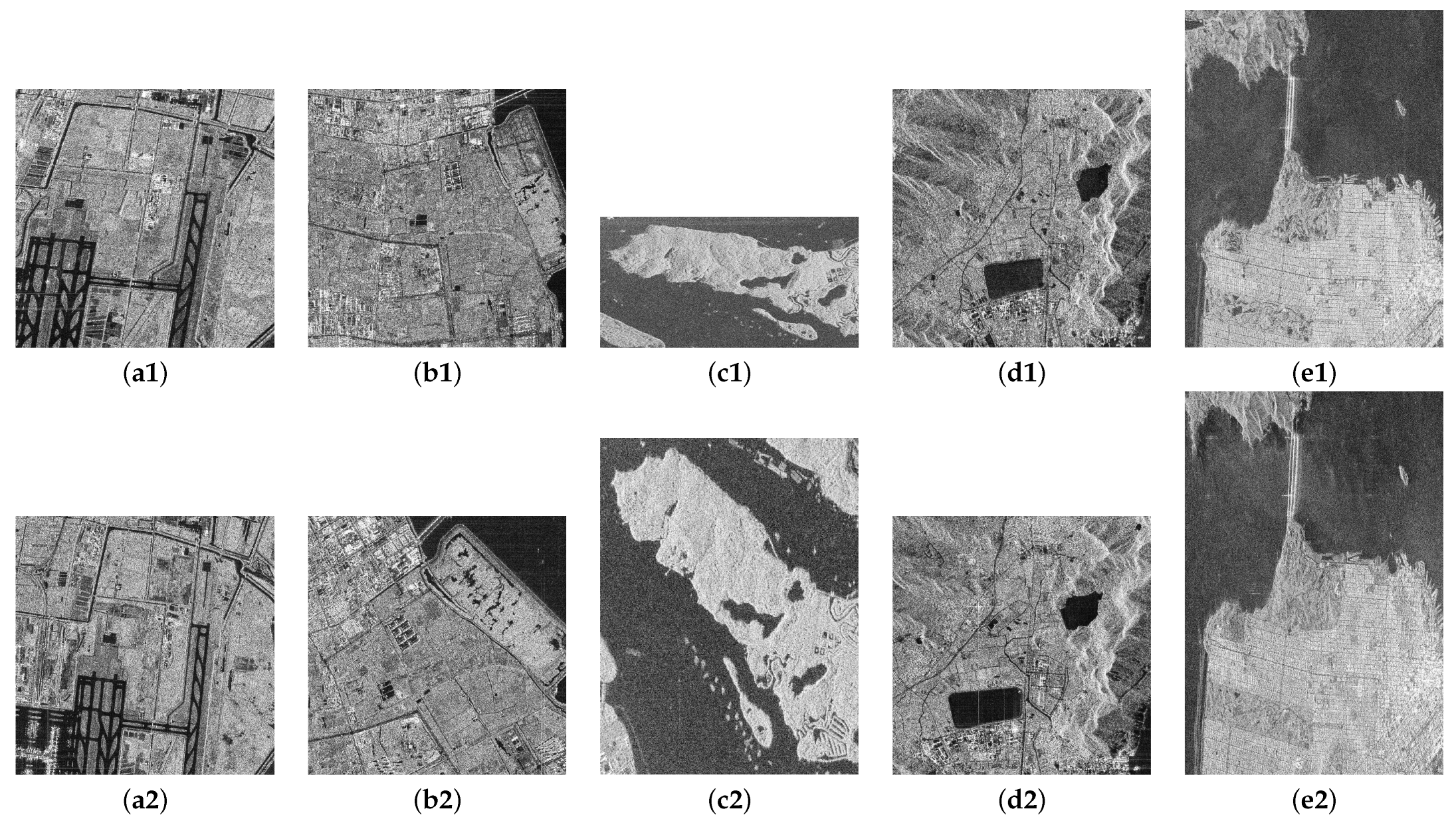
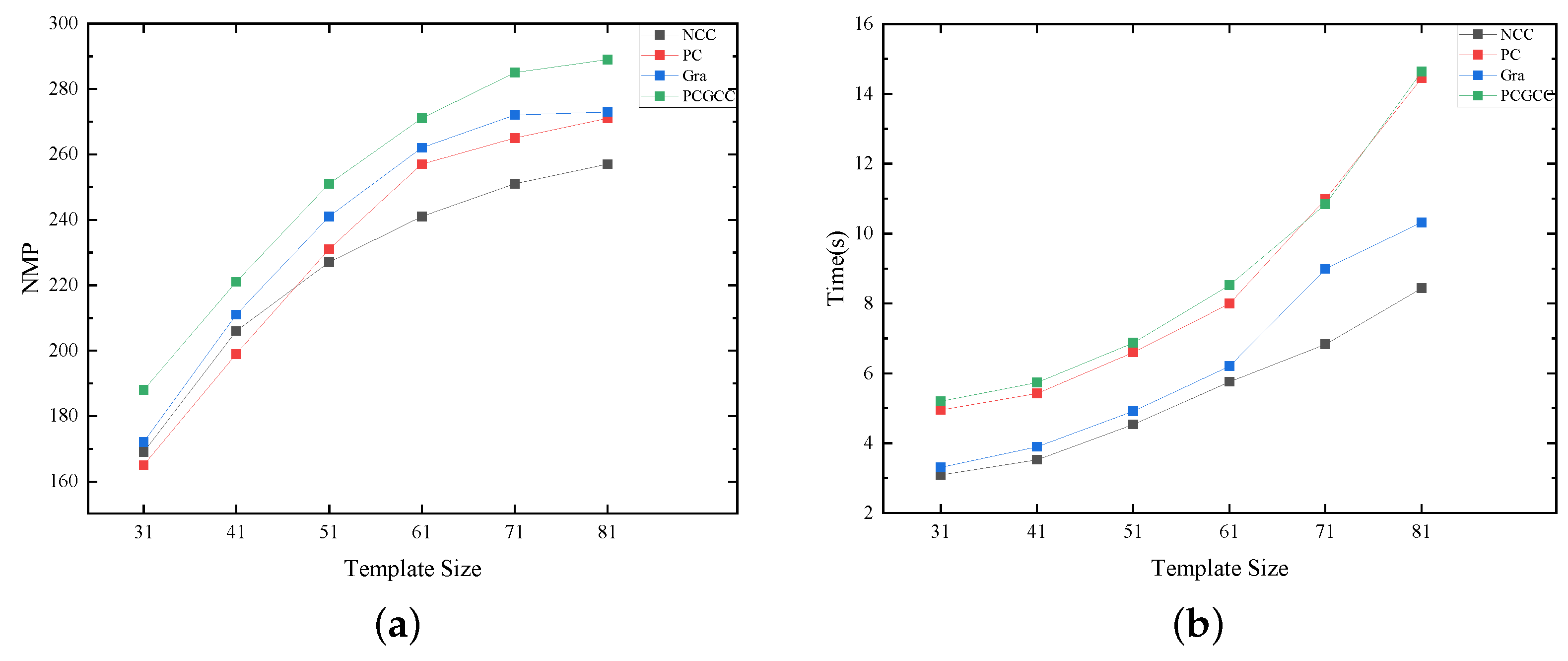
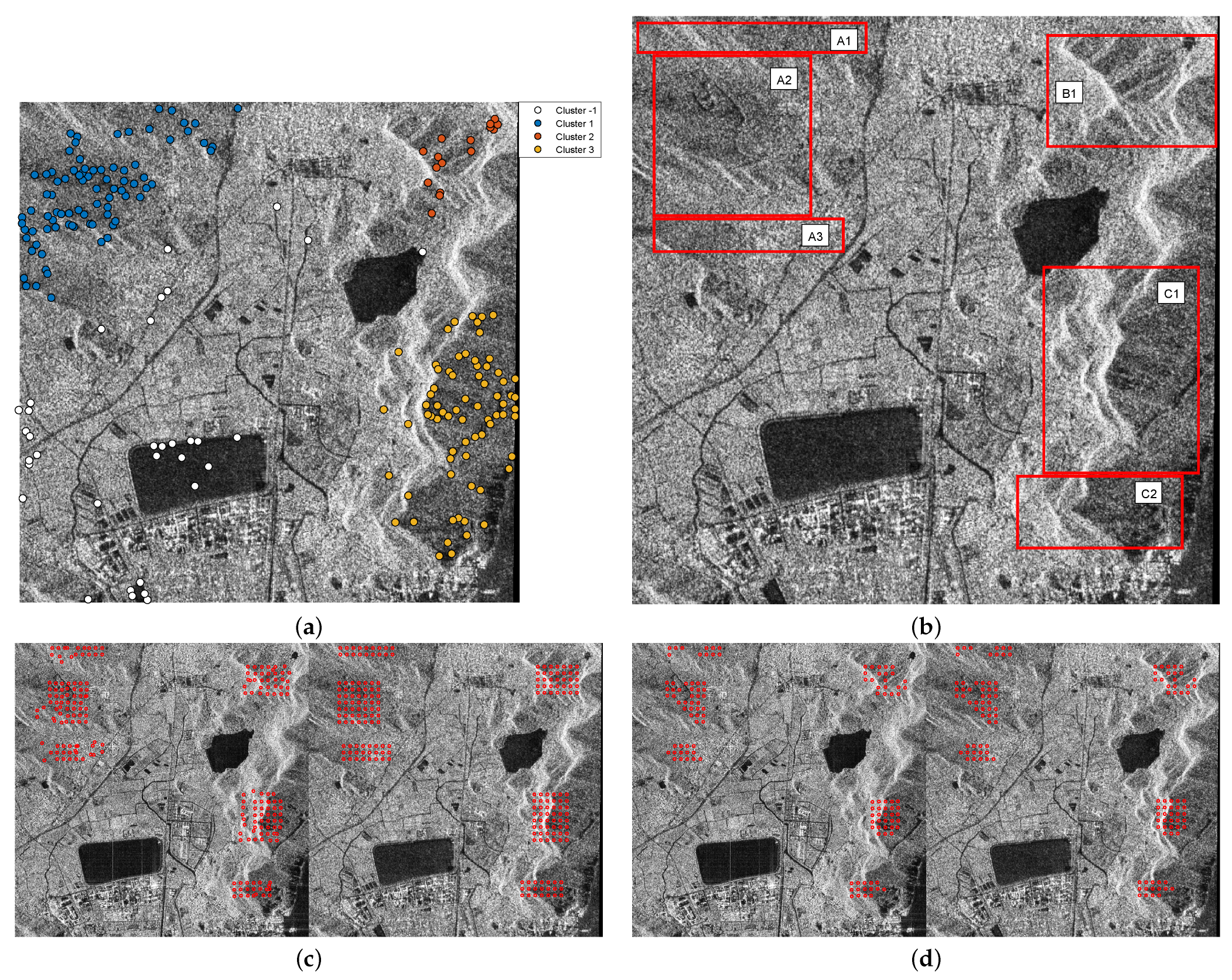
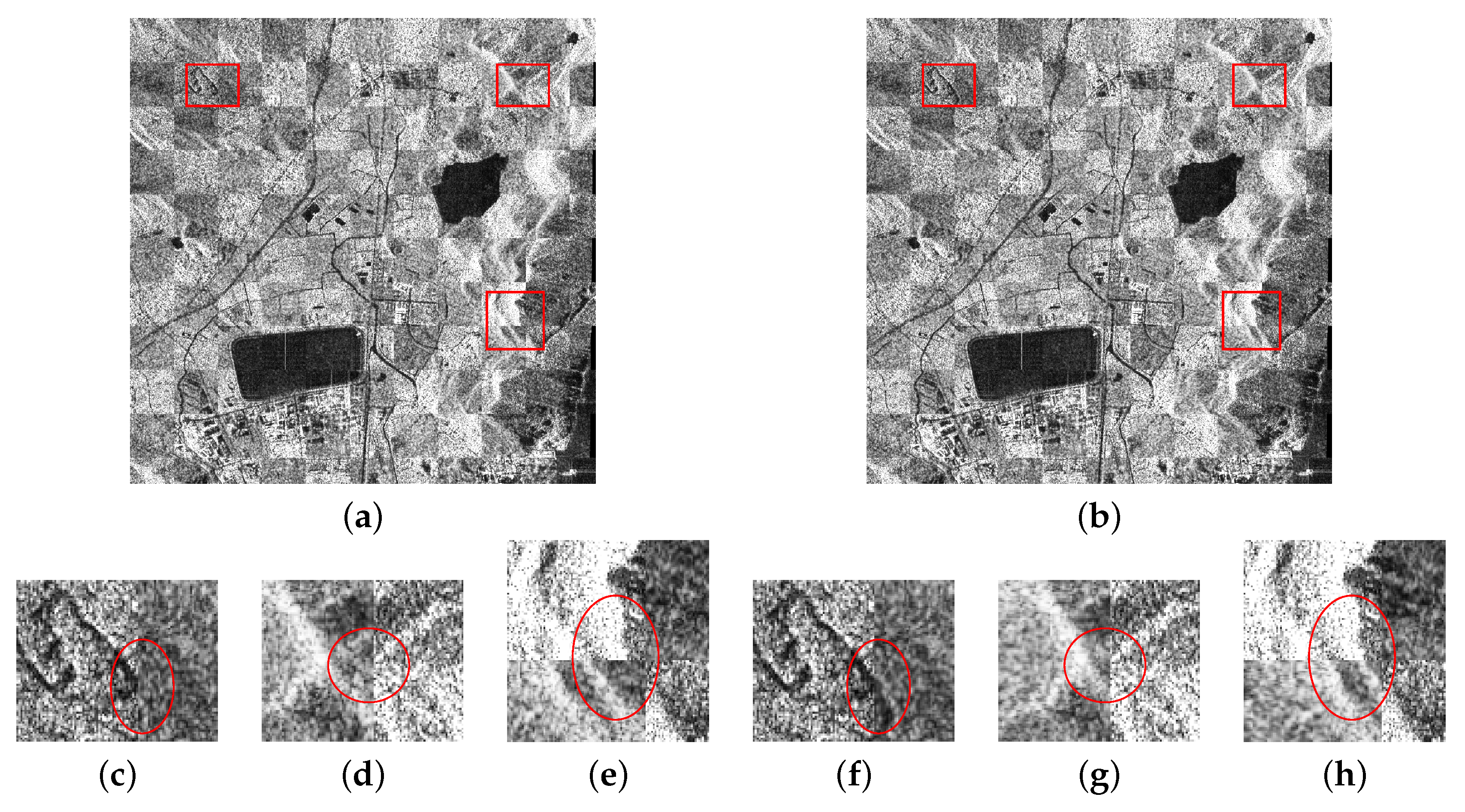
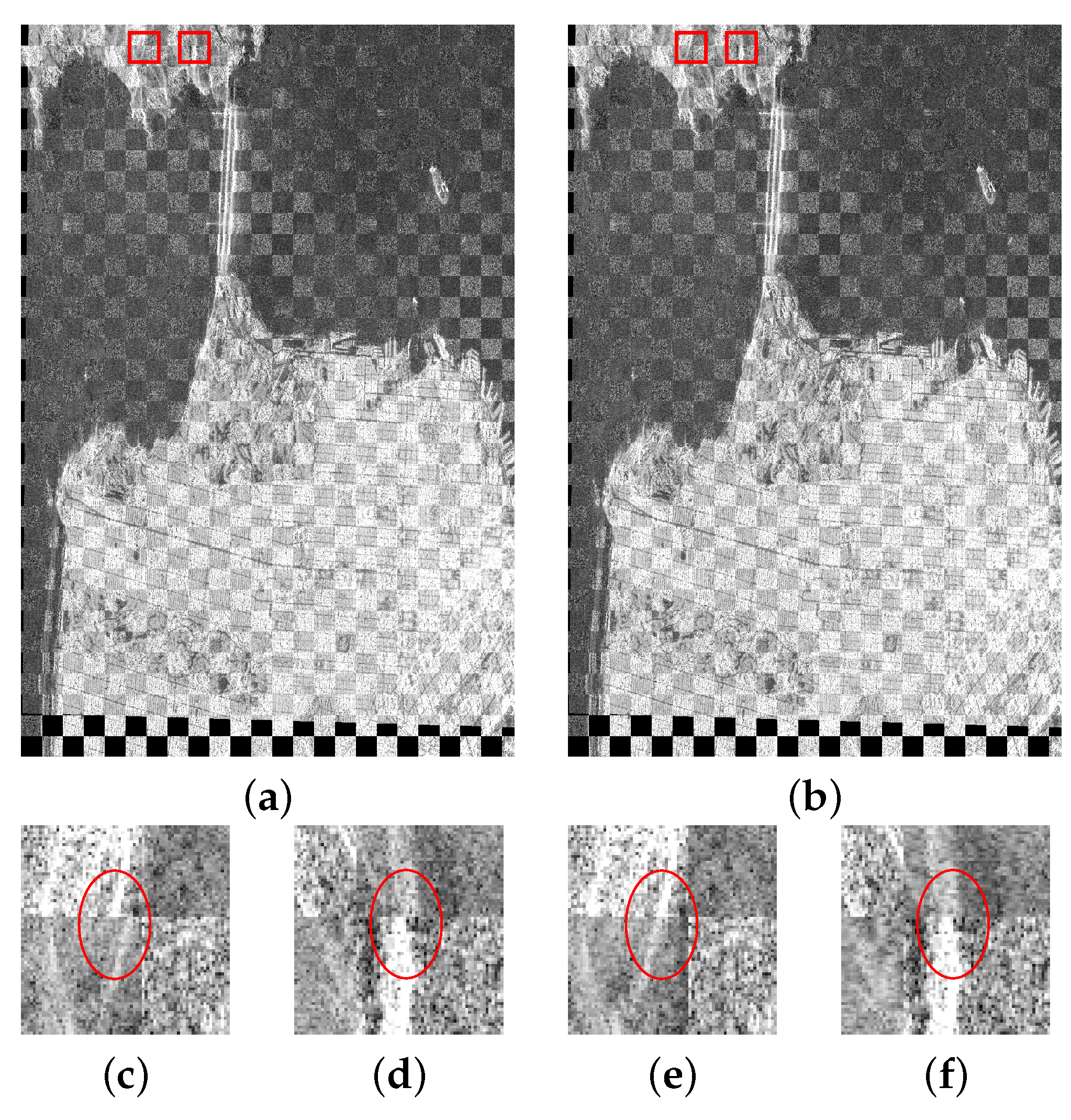
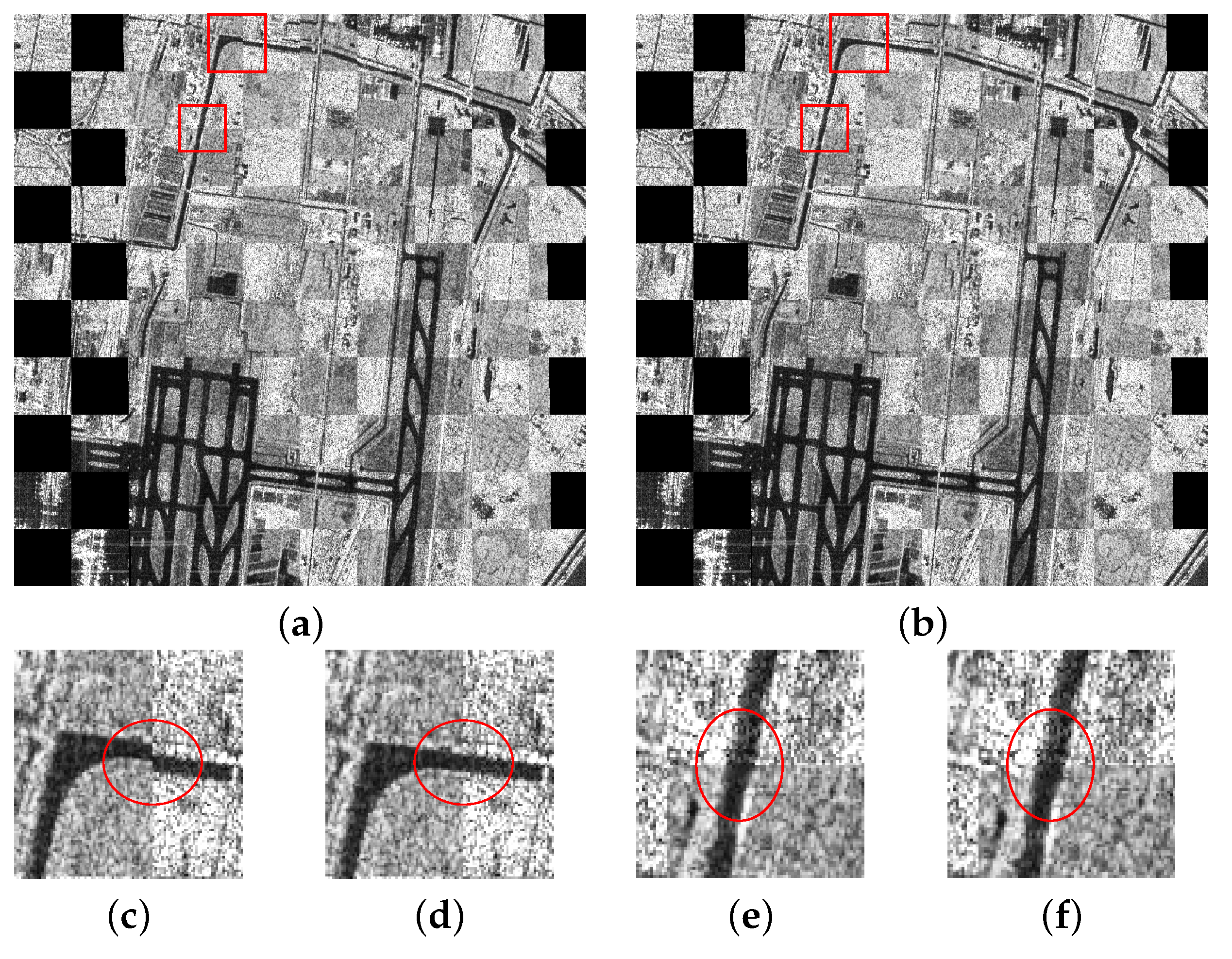
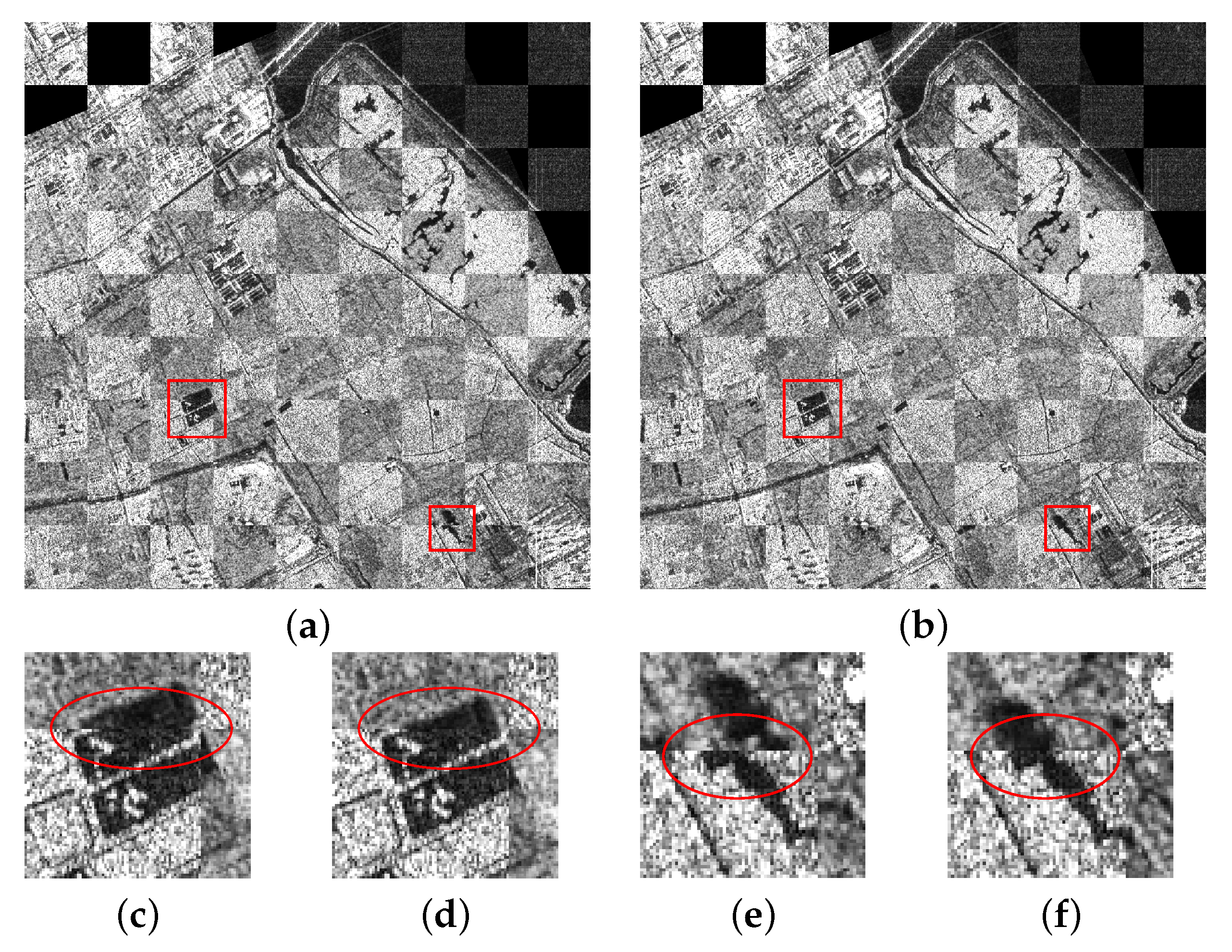
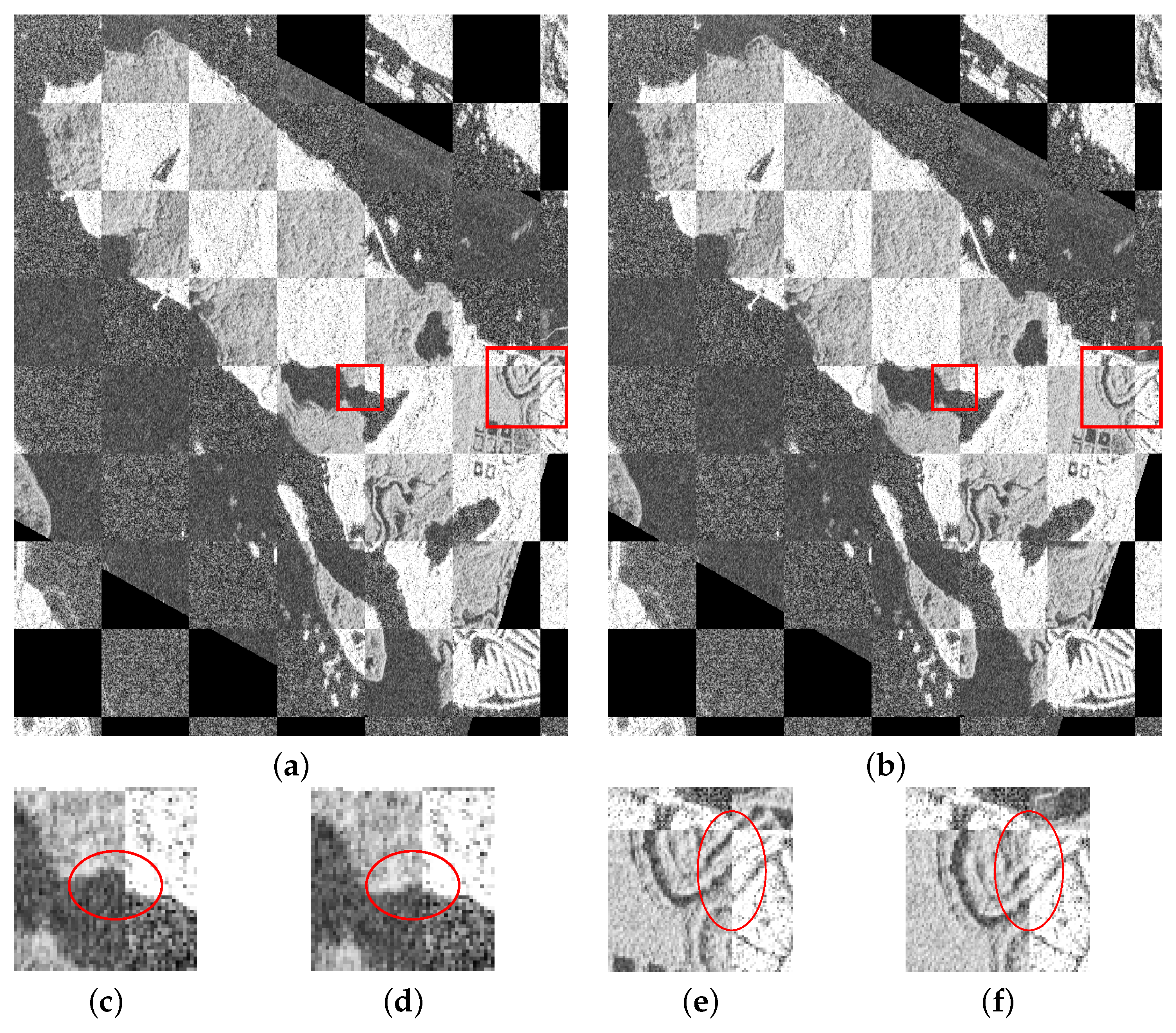


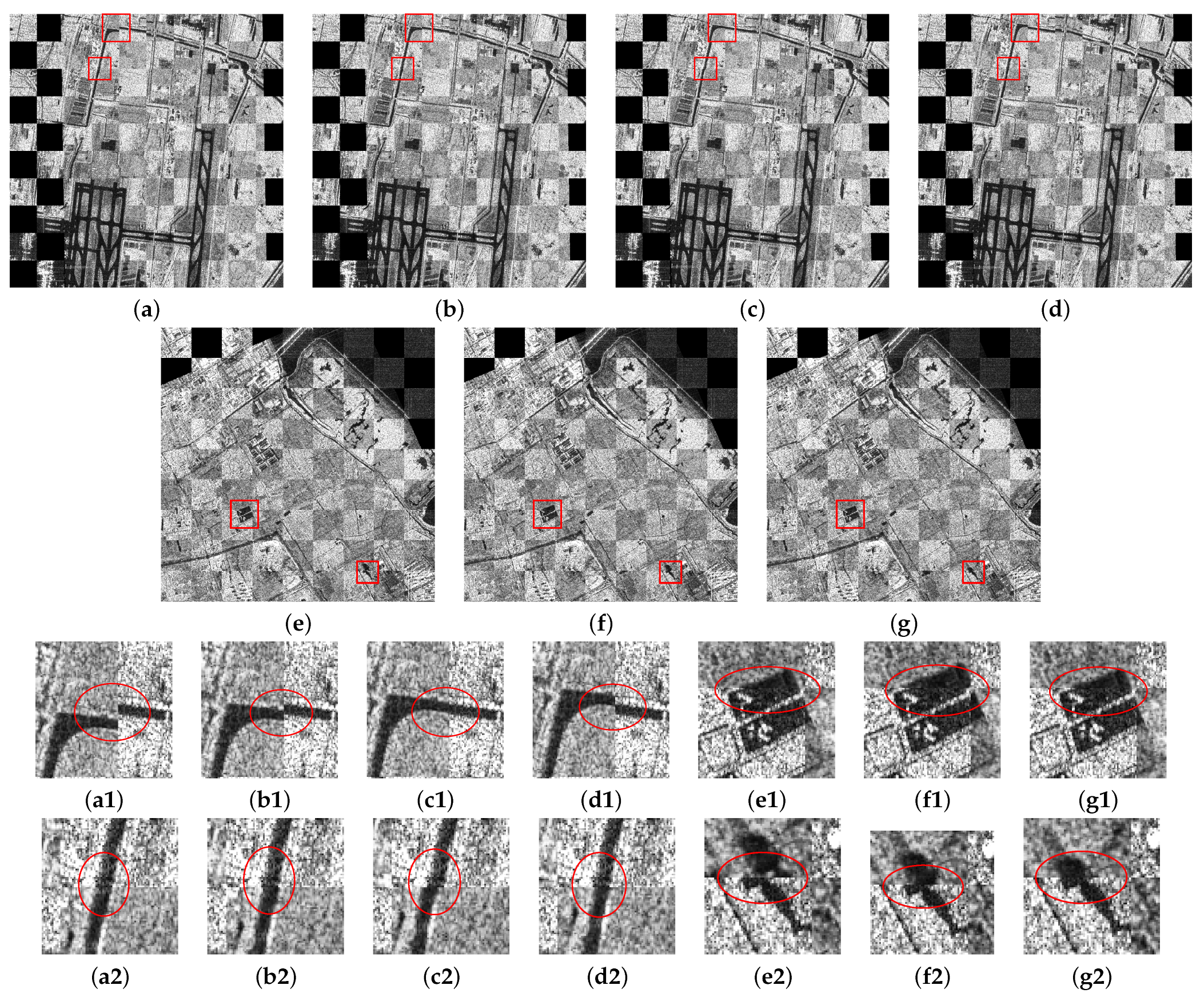
| Pair | Sensor | Date | Resolution | Angle | Direction | ENL | Size |
|---|---|---|---|---|---|---|---|
| 1 | GF3 | 24 September 2021 | 8 m × 8 m | 23.9 | ASC | 4.37 | 1000 × 1000 |
| GF3 | 11 November 2023 | 8 m × 8 m | 35.5 | ASC | 4.62 | 1000 × 1000 | |
| 2 | GF3 | 24 September 2020 | 8 m × 8 m | 25.5 | DEC | 3.57 | 900 × 900 |
| GF3 | 20 December 2021 | 8 m × 8 m | 20.1 | ASC | 5.41 | 900 × 900 | |
| 3 | TerraSAR-X | 10 March 2014 | 2.06 m × 6.59 m | 34.7 | DEC | 5.67 | 685 × 1351 |
| RADARSAT2 | 19 January 2013 | 4.73 m × 4.80 m | 46.7 | ASC | 6.07 | 821 × 631 | |
| 4 | GF3 | 30 September 2018 | 8 m × 8 m | 30.8 | ASC | 3.60 | 900 × 900 |
| GF3 | 20 November 2016 | 8 m × 8 m | 25.2 | ASC | 4.14 | 900 × 900 | |
| 5 | ALOS2 | 24 March 2015 | 6 m × 6 m | 30.8 | ASC | 5.69 | 2876 × 2205 |
| RADARSAT2 | 9 April 2008 | 4.73 m × 4.82 m | 28.0 | ASC | 5.38 | 1749 × 1180 |
| Pair | Evaluation Criteria | 1 | 1.5 | 2 | 2.5 |
|---|---|---|---|---|---|
| 1 | NOI | 7 | 3 | 3 | 3 |
| RMSE | 4.67 | 2.18 | 2.18 | 2.18 | |
| 2 | NOI | 14 | 11 | 9 | 3 |
| RMSE | 3.39 | 6.10 | 6.20 | 20.19 | |
| 3 | NOI | 13 | 5 | 5 | 5 |
| RMSE | 6.87 | 6.87 | 6.87 | 6.87 | |
| 4 | NOI | 15 | 5 | 4 | 3 |
| RMSE | 5.30 | 5.07 | 5.30 | 3.20 | |
| 5 | NOI | 4 | 4 | 4 | 4 |
| RMSE | 7.13 | 7.13 | 7.13 | 7.13 |
| Pair | 1 | 2 | 3 | 4 | 5 |
|---|---|---|---|---|---|
| NOI | 3 | 11 | 5 | 5 | 4 |
| Original RMSE | 2.26 | 25.73 | 5.19 | 4.35 | 7.68 |
| Final RMSE | 2.18 | 6.10 | 6.87 | 5.07 | 7.13 |
| Method | Pair 1 | Pair 2 | Pair 3 | Pair 4 | Pair 5 |
|---|---|---|---|---|---|
| NCC | 251 | 82 | 101 | 204 | 265 |
| PC | 265 | 79 | 109 | 216 | 195 |
| Gra | 272 | 92 | 155 | 211 | 222 |
| PCGCC | 285 | 103 | 164 | 235 | 228 |
| Pair | 4 | 5 |
|---|---|---|
| CRR | 3 | 2 |
| FRR | 6 | 1 |
| MTD (pixels) | 9, 11, 2, 16, 25, 18 | 6 |
| Time | 52.92 | 13.59 |
| Pair | SIFT | BFSIFT | SAR-SIFT | SAR-SIFT -Layer | SAR-SIFT -ISPCC | I-SAR-SIFT | SAR-SIFT -SWT | Pre | Fine | |
|---|---|---|---|---|---|---|---|---|---|---|
| NMP | 1 | 13 | 13 | 30 | 79 | 234 | 36 | 11 | 25 | 285 |
| RMSE | 2.31 | 2.53 | 3.12 | 0.97 | 0.52 | 3.42 | 2.02 | 2.18 | 0.55 | |
| Time | 29.86 | 26.24 | 59.48 | 58.21 | 21.86 | 128.93 | 32.23 | 16.57 | 11.20 | |
| NMP | 2 | 10 | 8 | 18 | 26 | 34 | 23 | 19 | 10 | 103 |
| RMSE | 4.55 | 4.43 | 1.71 | 5.88 | 4.16 | 3.66 | 3.92 | 6.10 | 0.74 | |
| Time | 20.62 | 15.90 | 33.06 | 43.86 | 15.83 | 90.96 | 25.57 | 25.26 | 12.02 | |
| NMP | 3 | * | * | * | 12 | 161 | 6 | * | 7 | 164 |
| RMSE | * | * | * | 4.28 | 0.75 | 10.59 | * | 6.87 | 0.69 | |
| Time | * | * | * | 32.72 | 29.96 | 41.98 | * | 18.43 | 13.84 | |
| NMP | 4 | 13 | 13 | 20 | 32 | 167 | 23 | 13 | 11 | 235 |
| RMSE | 5.76 | 4.42 | 4.29 | 2.71 | 2.04 | 4.00 | 4.25 | 5.07 | 0.66 | |
| Time | 18.38 | 15.64 | 30.02 | 35.66 | 16.42 | 86.44 | 22.05 | 10.58 | 69.35 | |
| NMP | 5 | 69 | 26 | 9 | 12 | 118 | 10 | 11 | 6 | 228 |
| RMSE | 2.25 | 1.86 | 1.77 | 8.37 | 1.37 | 3.22 | 1.45 | 7.13 | 0.85 | |
| Time | 177.09 | 131.90 | 81.19 | 51.84 | 80.81 | 225.82 | 96.11 | 26.05 | 45.78 |
Disclaimer/Publisher’s Note: The statements, opinions and data contained in all publications are solely those of the individual author(s) and contributor(s) and not of MDPI and/or the editor(s). MDPI and/or the editor(s) disclaim responsibility for any injury to people or property resulting from any ideas, methods, instructions or products referred to in the content. |
© 2025 by the authors. Licensee MDPI, Basel, Switzerland. This article is an open access article distributed under the terms and conditions of the Creative Commons Attribution (CC BY) license (https://creativecommons.org/licenses/by/4.0/).
Share and Cite
Liu, S.; Deng, X.; Liu, C.; Cheng, Y. SAR Image Registration Based on SAR-SIFT and Template Matching. Remote Sens. 2025, 17, 2216. https://doi.org/10.3390/rs17132216
Liu S, Deng X, Liu C, Cheng Y. SAR Image Registration Based on SAR-SIFT and Template Matching. Remote Sensing. 2025; 17(13):2216. https://doi.org/10.3390/rs17132216
Chicago/Turabian StyleLiu, Shichong, Xiaobo Deng, Chun Liu, and Yongchao Cheng. 2025. "SAR Image Registration Based on SAR-SIFT and Template Matching" Remote Sensing 17, no. 13: 2216. https://doi.org/10.3390/rs17132216
APA StyleLiu, S., Deng, X., Liu, C., & Cheng, Y. (2025). SAR Image Registration Based on SAR-SIFT and Template Matching. Remote Sensing, 17(13), 2216. https://doi.org/10.3390/rs17132216






